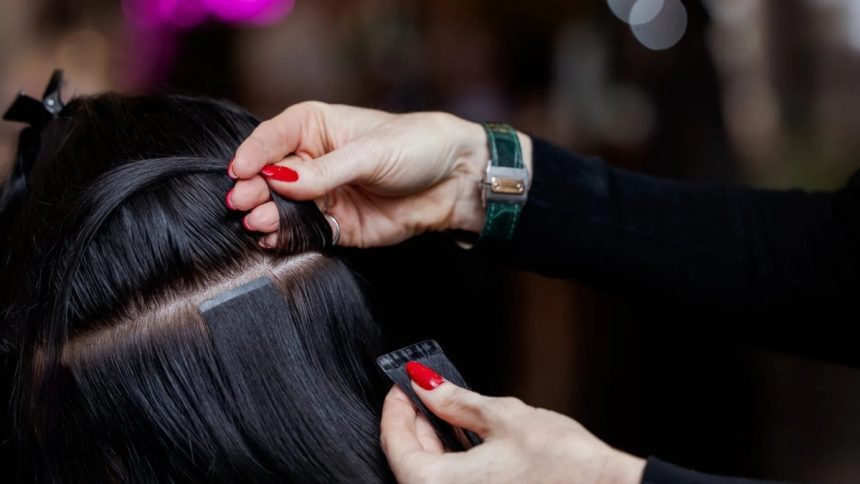When it comes to enhancing our hairstyles, hair extensions have become a popular choice for adding volume, length, and versatility. However, not all hair extensions are created equal, and some may contain chemicals that could pose risks to our health. By becoming more aware of what goes into these products, we can make informed choices that prioritize safety, sustainability, and overall well-being. Here’s a guide to help you navigate the world of non-toxic hair extensions and make healthier choices for yourself and the environment.
1. Identifying Harmful Chemicals in Hair Extensions
Many hair extensions on the market, especially lower-quality ones, may contain harmful chemicals that can affect not only your scalp health but your overall well-being. Commonly found toxins include formaldehyde, synthetic dyes, and harsh adhesives that can cause irritation, allergic reactions, and even disrupt hormonal balance over time. For example, some synthetic extensions are treated with flame-retardant chemicals that may emit fumes when exposed to high temperatures during styling.
When looking for healthier alternatives, opt for high-quality products like the Best Clip In Hair Extensions. These tend to be free of harsh chemicals, made from natural fibers or untreated human hair, which ensures a safer experience for your scalp and hair. Additionally, some companies provide detailed information on their production methods and chemical testing, so be on the lookout for transparency from manufacturers.
2. Choosing Natural Materials and Non-Toxic Options
One of the best ways to avoid potentially hazardous chemicals is by choosing extensions made from natural or minimally treated materials. Human Hair Wigs and natural hair extensions are often safer options because they undergo less chemical processing compared to synthetic counterparts. These products can typically be treated, styled, and cared for like natural hair, reducing exposure to harmful substances.
When shopping for hair extensions, prioritize products labeled as “100% natural” or “organic,” and avoid those that use heavy dyes, perfumes, or synthetic coatings. Extensions treated with plant-based dyes or free of toxic glues are less likely to cause irritation and help maintain your scalp health. Taking time to research and understand what your extensions are made of will go a long way in ensuring you’re choosing safer options for your hair and body.
3. Prioritizing Certified Non-Toxic and Eco-Friendly Extensions
As more people become conscious of their health and environmental impact, brands have responded by offering certified non-toxic and eco-friendly hair extensions. These extensions meet safety standards and contain fewer harmful ingredients, making them suitable for long-term use. Certifications from reputable organizations such as the Global Organic Textile Standard (GOTS) or OEKO-TEX are a good sign that the product you’re purchasing adheres to strict safety and environmental guidelines.
In addition to safer products, eco-friendly extensions minimize environmental harm by using sustainable materials and reducing chemical runoff during production. Many natural human hair wigs manufacturers have adopted eco-friendly practices by sourcing hair ethically and minimizing the use of toxins during processing. Supporting such brands not only promotes your health but also contributes to a more sustainable industry.
4. Maintaining Safe Care Practices
Beyond selecting non-toxic extensions, how you maintain and care for your hair extensions plays a critical role in ensuring safety and prolonging their lifespan. Many conventional hair care products contain sulfates, parabens, and other harsh chemicals that may not interact well with natural or minimally treated extensions. Instead, choose shampoos and conditioners that are free from these harmful ingredients, designed specifically for extensions and sensitive scalps.
When attaching or removing extensions, be gentle and use the recommended tools to prevent unnecessary stress on your scalp. Clip-in options allow for versatility and ease of use without excessive adhesive or bonding agents, which may irritate sensitive skin. By prioritizing proper maintenance and safer alternatives, you can protect your hair and scalp health over the long term.
5. Raising Awareness and Staying Informed
Staying educated about product safety is key to making informed decisions for yourself and your family. Read labels, research ingredient lists, and consult with trusted professionals who specialize in non-toxic hair care. Knowledge empowers you to select hair extensions that not only meet your styling needs but align with your health values.
Join forums, read reviews, and consider engaging with brands that are transparent about their production practices. The more awareness we bring to product safety, the greater demand there will be for healthier, non-toxic options, benefiting everyone in the process.
By choosing safer alternatives and maintaining a routine that aligns with health-conscious practices, you can embrace the beauty of hair extensions without compromising on your well-being. From selecting the right materials to maintaining safe care habits, these steps will ensure a healthier, more balanced lifestyle.
Lynn Martelli is an editor at Readability. She received her MFA in Creative Writing from Antioch University and has worked as an editor for over 10 years. Lynn has edited a wide variety of books, including fiction, non-fiction, memoirs, and more. In her free time, Lynn enjoys reading, writing, and spending time with her family and friends.















